Phonetic Analysis of Vowels and Consonants in Arabic Language in the Study of Ashwat Science
Keywords:
Arabic Phonetics, Learning Arabic, Science of SoundsAbstract
This journal discusses the importance of mastering Arabic phonetics, particularly vowels and consonants that significantly influence word meaning. Pronunciation errors can alter meanings considerably, especially in Qur’anic learning and daily communication. The study employs a qualitative descriptive approach, collecting data through observation, interviews, and literature review on Arabic phonetics and the science of Ashwat. The analysis categorizes types of vowels and consonants and examines the relationship between pronunciation and comprehension of meaning. The findings indicate that phonetic mastery is essential, particularly in distinguishing between short and long vowels and consonants with similar articulation points. The science of Ashwat plays a crucial role in helping learners recognize subtle sound differences, thereby enhancing their speaking, reading, and comprehension of religious texts. This research underscores the necessity of integrating Ashwat into Arabic language learning curricula at various levels.












